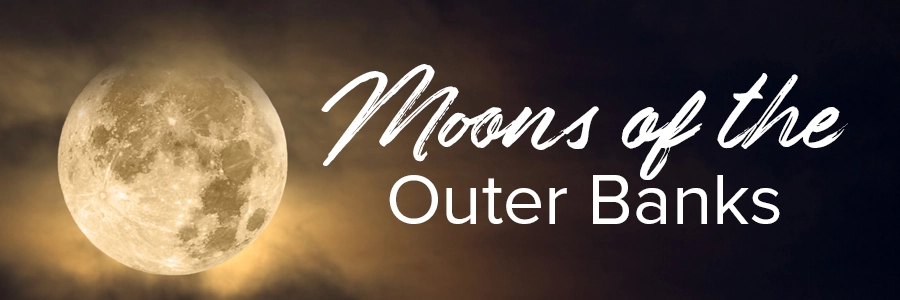This past Friday, those of us on the Outer Banks were able to witness something pretty awesome – a Harvest Moon ON Friday the 13th! Although Harvest Moons occur every fall, a Harvest Moon on Friday the 13th is a rare event that hasn’t happened since October 13, 2000 and won’t happen again until 2049! Plus, if you ask anyone who has seen a full moon on the Outer Banks, they will tell you that there is something magical about watching the full moon rise over the ocean, especially a rare moon.
But what exactly is a harvest moon? And didn’t the Outer Banks just see another special moon earlier in the year? We’ve put together this helpful guide about the Moons of the Outer Banks to answer all of your questions!
The Harvest Moon (Annual)
The Harvest Moon earns its name from the fall harvest. For several days before and after the full moon, the Harvest Moon rises near or right after sunset every day. Typically, the moon rise averages a 50-minute difference each night but around the Harvest Moon, the intervals are much smaller meaning those working in the peak of harvest season are able to work late into the evening by the light of the moon.
The date of the Harvest Moon each year depends on the moon cycle. The Full Moon that arrives nearest to the September Equinox is deemed the Harvest Moon. This is typically in September but every few years, the September full moon is the first week of September. This makes October's full moon the Harvest Moon.
The Strawberry Moon (Annual)
Like the Harvest Moon, the name Strawberry Moon derives from the relation to the crops harvested during its cycle. In the 1930’s, the Farmer’s Almanac printed a monthly list of Native names for every moon* and the name Strawberry Moon had been assigned for the widespread harvest of strawberries in North America.
The Strawberry Moon is either the last full moon in Spring or the first full moon in June each year. You may also hear the Strawberry Moon referred as the “Honey Moon” or “Mead Moon” which are names that trace back to Europe during the 1500’s. Earlier this year, the Strawberry Moon occurred on June 17, 2019 while next year’s Strawberry Moon will occur on June 5, 2020.
The Blue Moon (Rare)
A Blue Moon can be a “seasonal” or “monthly” Blue Moon. The name is speculated to come from many different origins but a Blue Moon is not actually blue in color. Every season—defined as the time between an equinox and solstice, or vice versa—there are 3 full moons. However, in cases where a fourth full moon occurs during a single season, the third moon becomes known as the Blue Moon, or the seasonal Blue Moon. The last seasonal Blue Moon occurred earlier this year on May 18, 2019 and the next won’t occur until August 22, 2021. This happens about once every 2.7 years.
Although this definition of a Blue Moon has been around for decades, many people would argue that a Blue Moon is the second full moon in a month. According to Space.com, a national radio program in the 80s once referenced a source containing a misrepresentation about what qualifies as a "Blue" moon. The definition became so commonplace that it is now generally accepted that in instances where a second full moon occurs within the same calendar month, the second full moon is also known as a Blue Moon, or rather, a monthly or calendar-month Blue Moon. The last calendar-month Blue Moon occurred on March 31, 2018 and the next will be on October 31, 2020.
The Supermoon (Rare)
A supermoon has to do with how close the moon’s orbit is to earth. The moon’s orbit—an oval-shaped path known as an ellipse—sometimes positions the moon close to earth and at other times, positions it far away. The point at which the moon is farthest from the Earth is called the apogee (at roughly 253,000 miles away) and the point at which the moon is closest to earth is called the perigee (roughly 226,000 miles away). In instances where a full moon or a new moon is located at the perigee, that moon is known as a “supermoon.” For full moon supermoons, the moon is known for being brighter and bigger than a normal full moon and according to Space.com, can actually appear up to 30% brighter and 14% larger although the increase is not always visible to the naked eye.
Some professionals debate the exact distance from earth that qualifies a supermoon. Governing bodies like the International Astronomical Union (IAU) have not provided clarification, however, because the term "supermoon" was actually coined by an astrologer and not an astronomer. Many astronomers refer to supermoons as “perigean moons.” Supermoons are also said to cause changes in tide and potential flooding due to the shift in gravitational pull (known as spring tides). Some people even theorize that supermoons can increase tectonic activity and trigger natural disasters but NASA disputes this insisting that lunar tides occur on Earth regularly without impacting the energy of the planet internally.
Earlier this year, we saw supermoons on January 21, February 19 and March 20**. The January Supermoon coincided with a Total Lunar Eclipse (giving the moon a unique blood red color), and visitors probably saw photos and articles deeming it the "Super Blood Wolf Moon." This is even less common than a supermoon so it was quite a specatcular sight to see. Notably, the supermoon of November 14, 2016 was actually the closest the Full Moon has ever been to earth since 1948. As far as next year goes, we’ll see supermoons occur on February 9, 2020**, March 9, 2020 and April 7, 2020 and May 7, 2020**.
**These dates are accepted as supermoons by the broader definition of what qualifies as a supermoon.
Other Monthly Moons*
The Farmer’s Almanac published a list of Native American moon names for every month’s full moon in the 1930's and this list is still widely recognized in North America. The names originated by Natives who used the moon cycles as identifying factors for seasons and optimal harvest times. Depending on the year, the moons may not stick to this list (such as in the case of a Strawberry Moon which generally occurs in September but every so often will actually occur in October). Of course, each month also has plenty of alternative names, especially names originating outside of North America, so if you’ve heard a moon name and it isn’t listed below, check out National Geographic’s article: “Phases of the Moon, Explained" for a detailed list.
January: Wolf Moon
February: Snow Moon
March: Warm Moon
April: Pink Moon
May: Flower Moon
June: Strawberry Moon
July: Buck Moon
August: Sturgeon Moon
September: Harvest Moon
October: Hunter’s Moon
November: Beaver Moon
December: Cold Moon
Witness A Full Moon For Yourself
Whether you're interested in astrology, astronomy, or just love the beauty provided by Mother Nature, you'll love watching a full moon rise over the ocean or one of our many beloved landmarks and lighthouses. To find your dream vacation home, simply click the button below! If you'd like a front row seat, check out Oceanfront Rentals—we even have some great deals and promotions to get you started!

About the Author: Jessie has been coming to the Outer Banks since she was just 5 years old. She loved it here so much that she finally relocated in 2018. Now her mission is to show the world that the Outer Banks is an incredible place that everyone should experience. When she isn't working, you can find Jessie hanging out with her friends, chilling at home with a good book, or discovering a new Outer Banks adventure.




